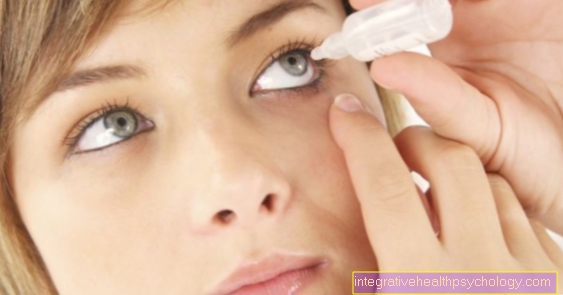Sebum hyperplasia
introduction
The sebum hyperplasia is a benign growth of the sebum glands.
It is usually found on the face, but can also be found on other parts of the body. A distinction is made between a presenile and a senile sebum hyperplasia.
Presenile sebum hyperplasia usually occurs in younger and middle age, whereas senile sebum hyperplasia occurs after the age of 35. Oil glands are usually not visible to the naked eye. They are located in our skin and produce the sebum that is important for the skin barrier. In the case of sebum hyperplasia, the sebum glands are enlarged for various reasons and palpable and visible as raised, yellowish papules. The term papule describes a growth of the skin that rises above the skin level.

Causes of sebum hyperplasia
There are various causes that can lead to sebum hyperplasia.
Senile sebum hyperplasia usually arises on the basis of immunosuppression. Immunosuppression is a condition in which the immune system is suppressed. This can be the case, for example, in the context of certain diseases, including bone marrow diseases, or medication. Senile sebum hyperplasias are particularly evident in people who receive drug therapy with active ingredients that suppress the immune system. A connection was observed, for example, with the use of the drug ciclospoprin A. The intake of such drugs is necessary for a wide variety of diseases. These include, for example, autoimmune diseases or severe neurodermatitis. In particular, seborrhoeic people seem to be affected by senile sebum hyperplasia. Seborrheic sufferers are patients who suffer from so-called seborrheic eczema. This skin disease mainly affects the sebum-rich skin on which many sebum glands can be found. The exact origin of the disease is currently still the subject of research. However, both genetic and environmental factors seem to play an important role. Furthermore, men are more often affected than women.
Presenile sebum hyperplasia almost exclusively affects men and is also more common in people with seborrheic dermatitis. In addition, the presenile sebum hyperplasia occurs more frequently after organ transplants under immunosuppressive therapy with cyclosporine. The frequently used drug is necessary after an organ transplant to prevent the organ from being rejected by the body's own immune system. However, this suppression of the immune system can lead to sebum hyperplasia.
Read more about this: Immunosuppressants
Diagnosis of sebum hyperplasia
The diagnosis of sebum hyperplasia is made by the dermatologist. First of all, the inspection of the skin is in the foreground. The doctor looks closely at the change in the skin. For a better diagnosis he can use a dermatoscope, which acts like a kind of magnifying glass to enlarge the skin findings. This allows the surface of the sebum hyperplasia to be better assessed. As a rule, the diagnosis of sebum hyperplasia can already be made in this way.
Important development factors, such as seborrheic dermatitis or the use of medication that suppress the immune system, continue to help make the diagnosis. Senile sebum hyperplasias in particular can resemble white skin cancer, also known as basal cell carcinoma or basalioma. In this case, the skin lesion is removed and examined under a microscope. This is called a histological examination. This is where the glandular material of the sebum glands, as well as sebum and horn masses, are typically found.
What are the symptoms of sebum hyperplasia?
The sebum hyperplasia does not cause any symptoms and is only a cosmetic problem. Presenile sebum hyperplasia is characterized by the grouped arrangement of several, approximately 2-5 mm large skin changes. These changes are slightly raised above the skin level and have a soft consistency. They are also known as papules. They are yellowish-brown in color and have a central dent in their center.
It is similar with senile sebum hyperplasia. Here, too, there are usually several sebum hyperplasias present at the same time, but they can also occur individually. The surface of the sebum hyperplasia usually has a lobed or, more rarely, a bumpy structure and feels waxy. In both forms of sebum hyperplasia, the surrounding skin is usually characterized by a high level of sebum production, which is also known as seborrhea. The skin typically feels oily.
Concomitantly, seborrheic dermatitis can also occur. This clinical picture is characterized by yellowish, oily scales and is usually accompanied by reddening of the skin. Sebum hyperplasias are mostly found on the face or chest. Accompanying symptoms such as itching or pain do not occur.
You may also be interested in this topic:
- Oily skin
- Overactive sebum
How can you remove sebum hyperplasia?
Sebum hyperplasias can be removed by a dermatologist. Various options are available for this.
One way of removing sebum hyperplasia is through traditional surgical therapy. The sebum hyperplasia is cut out and the edges of the skin are then sutured together. This method can leave a small scar. Surgical removal is primarily sought if the sebum hyperplasia cannot be reliably differentiated from skin cancer (basalioma). The removed tissue is then examined under a microscope.
Another method to remove sebum hyperplasia is laser treatment or freezing (cryotherapy) with liquid nitrogen. Photodynamic therapy or a salicylic acid peeling are also possible treatment approaches for sebum hyperplasia.
Read more on the subject at: Removal of sebum glands
Laser treatment
Laser treatment is a gentle and cosmetically very satisfactory way to remove sebum hyperplasia.
Various lasers are available for this treatment, including the CO2 laser and YAG laser. The skin changes are treated with the laser at a distance from the healthy skin and thus removed. After the laser treatment, scabs and reddening of the affected area are typical. Sweaty exercise and the sun should be avoided for at least a week so as not to impair wound healing.
The prerequisite for laser treatment is a reliable diagnosis of the sebum hyperplasia. If the diagnosis is uncertain, surgical removal must be carried out so that the removed skin lesion can then be examined under the microscope.
forecast
Sebum hyperplasias are benign skin changes that are not harmful to health.
However, they pose a cosmetic problem for many people, especially when they are localized in visible areas such as the face. Unfortunately, sebum hyperplasias do not usually resolve on their own. They cannot be removed by cosmetics or care products either. However, good skin care and consistent light protection can prevent the development of further sebum hyperplasias.
Occurrence on the face
The face is one of the most common sites of sebum hyperplasia.
There are naturally many sebum glands on the face, especially in the so-called T-zone. This includes the forehead and the bridge of the nose. The lateral cheek region is also often affected by sebum hyperplasia. The localization on the face is a cosmetic impairment for many sufferers, especially when multiple sebum hyperplasias occur.
So-called basaliomas, which are an important differential diagnosis of sebum hyperplasia, are often found on the face, especially in older people. In contrast to sebum hyperplasia, basaliomas are malignant skin changes. An important measure for the prophylaxis of such skin changes consists in a consistent light protection of the skin. The face is often forgotten.
Occurrence on the nose
The nose, like the face in general and the chest, is one of the typical sites of sebum hyperplasia. The skin changes there are often perceived as particularly annoying because they are clearly visible and also stand out from the rest of the face. Surgical removal can be more difficult on the nose than on other parts of the body, depending on where exactly the hyperplasia is located. It depends on the size and depth of the hyperplasia.
You might also be interested in this topic: Clogged sebum- what to do?
Occurrence on the forehead
The sebum hyperplasias also occur preferentially on the forehead. The forehead belongs to the so-called T-zone of the face.
There are many sebum glands, which especially in seborrhoeic patients produce increased sebum. The forehead then usually feels oily and can be shiny. Sebum hyperplasias can occur here individually or in groups and above all represent a cosmetic problem. They can be removed surgically or with a laser, for example.
Also read our article: Inflammation of the sebum
Difference from basalioma
Basalioma is an important differential diagnosis to sebum hyperplasia.
Basalioma is skin cancer that primarily affects the elderly and occurs after years of exposure to sunlight. Genetic factors also play an important role in the development. Basalioma can be very similar to sebum hyperplasia, which is why a careful examination is very important to differentiate it. Basaliomas are often reddish and show a central indentation, which, however, unlike the indentation of sebum hyperplasia, resembles a crater. This crater can be ulcerated. This means that there are minor injuries in the crater. Basaliomas are often found on the nose or eyelids. They grow very slowly and usually develop over several years.
Read more about basalioma at: Initial stage of basalioma





























